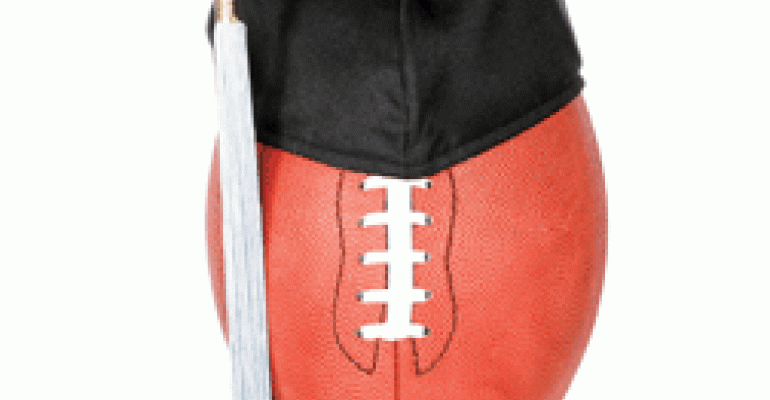
Do you have clients who think that their teenagers are going to win athletic scholarships?
You probably do, because proud parents are notorious for overestimating their kids' athletic abilities. What many moms and dads don't understand is that the odds of capturing one of these prizes are stacked against all but the most gifted athletes. Only 2 percent of high school athletes end up earning a sports scholarship.
If parents understood the miserable odds, they might encourage their teenagers to focus more on their schoolwork, which is far more important than what happens on a football field or a basketball court. And as a practical matter, academic scholarships are far more plentiful and lucrative than the awards that most athletes receive.
I'm going to share some of the realities that teens face when they pursue sports scholarships. And for those who aren't discouraged, I'm going to devote the next column to revealing ways to increase teenagers' chances of winning a spot on a college sports team.
Here are seven things you need to know about sports scholarships:
- The odds are stacked against high school jocks.
Here are two examples of the lousy odds: The most popular high school sport for boys is football. More than 1 million teenage boys play football, but recently just 28,300 received a scholarship from a Division I or II school. Track and field is the most popular high school sport for teenage girls. More than 600,000 participate, but recently fewer than 10,000 athletes captured one of these track scholarships.
- Sports scholarships are typically modest.
The average sports scholarship was worth $10,409, according to an analysis by The New York Times of NCAA scholarship data. The average value for many sports was far lower, such as men's baseball ($5,806), men's golf ($6,338) and women's water polo ($7,793).
The sports with the most lucrative scholarships are men's and women's ice hockey. According to The New York Times data, the average hockey scholarship for men and women respectively was $21,755 and $20,540.
- Full-ride scholarships are rare.
There are only six college sports in Division I that offer either full-ride athletic scholarships or none at all. These sports are men's football, men and women's basketball, as well as volleyball, gymnastics and tennis for women.
All other sports are considered “equivalency” sports. For these sports, such as baseball, swimming, soccer, golf and lacrosse, the NCAA caps how much money a university can spend on individual sports. A coach will then parcel the cash out to as many hot prospects as possible. This is a practice that can lead to scholarships that may amount to only $2,000 or $3,000.
- Sports scholarships can vanish.
NCAA rules prohibit four-year athletic scholarships. Schools can only award one-year scholarships. Coaches have the power to renew scholarships, which can put tremendous pressure on college athletes to devote more time and energy to their sports than their school work.
- Getting into the Ivy League is easier for athletes.
While Ivy League schools don't award sports scholarships, recruited athletes enjoy a far greater chance of getting into these exclusive schools. In fact, jocks are four times more likely than other applicants to be accepted, according to Reclaiming the Game: College Sports and Educational Values, which was co-authored by William G. Bowen, a former president of Princeton.
Robert Malekoff, a past associate athletic director at Harvard University and a former Princeton soccer coach, agrees. When I interviewed Malekoff last year for an article for CBS MoneyWatch, he said there is “no question that there is an admission advantage for students who play sports'' at elite schools.
- Division III schools can be more generous.
The NCAA forbids Division III schools from giving college scholarships, but some student athletes will enjoy a better deal from these schools, which are typically smaller, private institutions. Well-known Division III schools include Amherst College, Williams College, MIT, Tufts University, Emory University and Washington University, St. Louis.
The schools mentioned above, along with other elite schools, provide very generous financial aid packages to their students. The value of these financial aid packages can far exceed the typical athletic scholarship. Many Division III schools also award merit scholarships to affluent students who don't qualify for need-based aid.
What's also nice about the awards that students can get from Division III schools is that it's not dependent upon students playing a sport. If a hot basketball prospect decides he no longer wants to play basketball, he can retire his tennis shoes and still keep his aid package.
- Student-athletes can be limited in their majors.
A USA Today survey of 142 universities with top sports programs revealed that many athletes playing in football, basketball, softball and baseball were clustered in majors that aren't as academically demanding. Eighty- three percent of the schools had at least one team in which at least 25 percent of the juniors and seniors shared the same major. At Boise State, 48 percent to 50 percent of the upper classmen on the football and men's and women's basketball teams majored in communications. Fifty-eight percent of upperclassmen on University of Southern California's football team majored in sociology.
Here's the bottom line: Many student athletes will obtain greater financial aid packages or merit scholarships from colleges based on their academic record and not what they do with a ball, bat or club.
Writer's BIO:
Lynn O'Shaughnessy
is a college consultant, author and speaker and she writes three college blogs for CBSMoneyWatch, US News & World Report and TheCollegeSolutionBlog.com.


